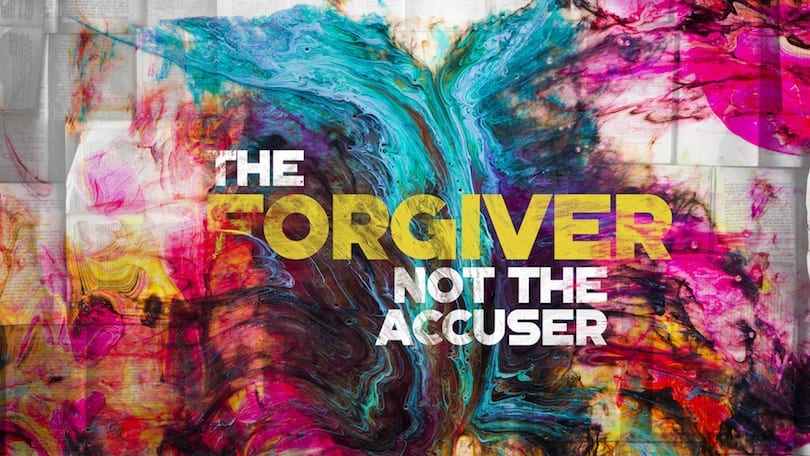
What did Jesus mean in John 8:7?
Sermon Summary: It is easy to point out everyone else’s sin and forget that we have our own glaring weaknesses. God’s grace is sufficient for us, no matter what we have done. In the beginning of John 8 we see the character of Christ toward sinners who break the commands of God and the freedom that comes by accepting His Grace.
Watch the sermon Here:
The Outline:
The Goodness of God in the Face of Evil
(see Romans 5:12, Psalm 46:1 and 2 Peter 3:9)
Our promise is that God will reign over evil and end all suffering. Until then, we wait with expectant and repentant hearts.
John 8
Scripture can be trusted as reliable, authoritative and accurate.
Jesus establishes our righteousness on the foundation of God’s grace, not our obedience.
Come for Grace—And Sin No More.
Transcript:
The Goodness of God in the Face of Evil
Two weeks ago, tonight, the United States experienced the worst shooting in our history. 58 lives taken, hundreds of lives changes, and millions of people left with questions—The main one being, why? For two weeks, the media and the police have been trying to answer the motive—as if knowing why would somehow help us cope. A group in California asked people, if you could ask God one question, and be sure He would answer, what would you ask? The vast majority simply answered this survey by saying they would ask God “Why?”
Why? Is something that has plagued us all over the last two weeks; it is the same question we ask anytime tragedy happens. As Colorado residents, we are no strangers to shootings. The Columbine shooting in 1999 left many of us who call Littleton home asking, why? Five years ago, after the Aurora theatre shooting, we also asked, why? But we ask the same question when money is stolen, cancer strikes, a car accident happens or a job is lost. Why? Why? Why?
The Bible already answered this why? question for us: Evil entered the world. This wasn’t God’s design. The original world God created was flawless, sinless and without suffering. Romans 5:12 says, “When Adam sinned, sin entered the world. Adam’s sin brought death, so death spread to everyone, for everyone had sinned” (NLT). Evil entered the world and marred God’s design, not out of God’s control, but under God’s control, yet still not His original design or desire.
The Bible says that God is our refuge and strength, ever present help… when?… in times of trouble (Ps. 46:1). Not if trouble comes, but when it comes. Evil does and will exist in the world. It was not created by God, but by the sin of man.
Yeah, but if God didn’t create evil, why does He allow it?
A man I trust a lot, a great pastor and evangelist, Greg Laurie, wrote this last week about the shooting: “Remember, that mankind was not created evil. In their original state, Adam and Eve were innocent, ageless, immortal. Bit from the beginning—for the time that God gave life to Adam and Eve, man has had the ability to choose right or wrong. He made his choice (and then his choice made him!). Had man never sinned, there would have been not resulting curse. But now it is too late.”
But our hope lies in the fact that there will be a day where the Lord recreates us all and the world into the original design He intended—where he will “Wipe every tear from our eye” and there will be no more suffering. Yeah, but why doesn’t He do that now? Why doesn’t He save us all now?
The answer is found in 2 Peter 3:9, “The Lord is not slow to fulfill his promise as some count slowness, but is patient toward you, not wishing that anyone should perish, but that all should reach repentance.” Friends, I too am ready for suffering to be over. I don’t want another shooting or “World War III.” But I know that God has promised a day when all will be redeemed—and His timing is perfect. In his perfection, he is patient, waiting for us all to reach a state of repentance. Our promise is that God will reign over evil and end all suffering. Until then, we wait with expectant and repentant hearts.
Call for salvation and prayed for today’s message
Listen, this may seem backwards to some of you—but I want to start today’s message by saying, if you do not know Jesus as your Lord, you need to turn to Him now. He is waiting for you to come to him in desperation and surrender. I want to invite you to make that decision today. I know the evil in the world makes me anxious—but I also know the one who can calms all anxiety. If you don’t know my Jesus, I know how you can cope. AS we pray for our time in the Bible today, I want to invite you—if you’ve yet to trust Jesus, do so now!
WILL YOU PRAY WITH ME? [Pray for (1) salvations, (2) peace, (3) a greater understanding of God’s Heart through today’s passage.]
John 8. I’ve entitled today’s message: The Forgiver, not the Accuser
Alright, will you come encounter God with me as we unpack this text? Please open your Bible with me to page 893, John 8. You can also follow along on the Grace Chapel App and use the Bibles that are located in front of you. We are going to be in John 8 until Thanksgiving. I encourage you to read it several times through over the next few weeks as we unpack it here on Sundays.
Let’s read the entire passage together and then we will talk about it, the difficulties with it, the application of it and what in it can change your life. Please stand with me and let’s read this outload together, starting in 7:53:
They went each to his own house, 1 but Jesus went to the Mount of Olives. 2 Early in the morning he came again to the temple. All the people came to him, and he sat down and taught them. 3 The scribes and the Pharisees brought a woman who had been caught in adultery, and placing her in the midst 4 they said to him, “Teacher, this woman has been caught in the act of adultery. 5 Now in the Law, Moses commanded us to stone such women. So what do you say?” 6 This they said to test him, that they might have some charge to bring against him. Jesus bent down and wrote with his finger on the ground. 7 And as they continued to ask him, he stood up and said to them, “Let him who is without sin among you be the first to throw a stone at her.” 8 And once more he bent down and wrote on the ground. 9 But when they heard it, they went away one by one, beginning with the older ones, and Jesus was left alone with the woman standing before him. 10 Jesus stood up and said to her, “Woman, where are they? Has no one condemned you?” 11 She said, “No one, Lord.” And Jesus said, “Neither do I condemn you; go, and from now on sin no more.”
Now there are two things we can say about this passage right away: (1) it is a great and riveting story—you can almost feel the suspense of the moment as Jesus is writing in the dirt and the fate of this prostitute hangs in the balance. (2) This is one of the most historically controversial passages in the Gospel of John. Let me explain.
This is a rare passage in the Bible where scholars believe it may not be a part of the original “Bible” but was added later. In most of your Bibles, you notice that John 7:53 to John 8:11 is either has brackets or footnote. In the ESV it has double brackets around it and this statement listed above the passage: “The earliest manuscripts do not include 7:53–8:11.” Most New Testament scholars do not think it was part of the Gospel of John when it was first written, but was added centuries later. Don Carson, who teaches at Trinity, and is in my view one of the best New Testament scholars in the world, writes, “Despite the best efforts . . . to prove that this narrative was originally part of John’s Gospel, the evidence is against [them].”[i]
Bruce Metzger, one of the world’s great authorities on the text of the New Testament until his death in 2002: “The evidence for the non-Johannine origin of the periscope of the adulteress is overwhelming.”[ii] Another commentator, Leon Morris wrote: “The textual evidence makes it impossible to hold that this section is an authentic part of the Gospel.”[iii] And Andreas Köstenberger, one of my favorite writer on John said, “[There is] overwhelming evidence that the section is non-Johannine.”[iv] Bottom line: this story was not written by or originally included in the Gospel of John.
Some of you are sitting there saying, “So what?” Others are sitting there—like my sister originally was—saying, “Wait, you are saying there are something in the bible that are not originally in the Bible?” Yes, that is what I am saying, and we should address it or you may start questioning Scripture and its accuracy.
If we don’t address this concern, some of you will questions – “Well if this part does not belong in the Bible, then maybe others don’t belong.” That is a wrong assumption. The whole of Scripture can be trusted as reliable, authoritative and accurate, and I would add that the forthrightness of scholars to point out this has its flaws only adds to the veracity and authenticity of the other parts.
Let me summarize the reasons scholars give for thinking this the story of the woman taken in adultery was not originally part of John’s Gospel then we will close at what this passage teaches us because I still believe it is useful for us.
Reasons This Section Isn’t Original to John’s Gospel
- This story missing from all the Greek manuscripts of John before the 5th Before the 400’s this story is never found in original copies. If John was written in probably between 90-100 A.D. John died by 100 A.D. So this story was add three hundred or more years after John died.
- All the earliest church fathers omit this passage in commenting on John and pass directly from John 7:52 to John 8:12. No Early church father cites the passage before the 10th century when dealing with this Gospel.
- In fact, the text flows very nicely from 7:52 to 8:12 if you leave out the story and just read the passage as though the story were not there.
- When this story starts to appear in manuscript copies of the Gospel of John, it has been put in three different places other than here (after 7:36; 7:44; and 21:25), and in one manuscript of Luke, it shows up after 21:38.
- Its style and vocabulary is unlike the rest of John’s writing.
Now if you are sitting there and going, why didn’t anyone ever tell me this? That is because this idea of “textual criticism” is not something most people know about or talk about. It is a highly technical field of scholarship that at the upper levels requires not only the ability to read ancient languages, but to read them in kinds of ancient handwritten scripts that are very demanding. I have given you just enough to make sense of why this footnote is in your Bible.
But now, let me ease your mind: No doctrine threatened in this passage.
In our passage, John 7:53–8:11, no truth that this Gospel teaches is changed by adding or omitting this story. Commentators Bruce and Wegner said we have not reason to “question of historic fact or of Christian faith and practice“[v] and “It is important to keep in perspective the fact that only a very small part of the text is in question.“[vi]
Reason to Worship God = God Preserves His Word
While I agree with the vast majority of scholars that the story of the woman taken in adultery was not in the Gospel of John, you should not think: “Oh my, everything is up for grabs now.” Or: “How can I trust any text now?” On the contrary, you can be thankful that God has, in his sovereign providence over the transmission process for 2,000 years, ordered things so that the few uncertainties that remain alter no doctrine of the Christian faith. This is astonishing! We should worship God because of it!
So What is a preacher to do with this passage?
We could be like those before the 10th century and just leave it out, but for some reason that doesn’t seem right. So, you know what I think we do with it: we preach it! Why? Because though we cannot trace it to have been written by John, it is still a valuable story that could be true and is like our Savior and it shows us His heart. Both Don Carson and Bruce Metzger think the story probably happened. In other words, they think this is a real event from Jesus’ life, and the story circulated and later was put in the Gospel of John.[vii]
Let’s be honest: who doesn’t love this story? But just loving a story doesn’t give it biblical authority. So, what I will do is take its most remarkable point and apply its truth based on other parts of Scripture. Let this story not be the basis of our authority, but an echo and a pointer to our authority, namely, the Scriptures, that teach what it says. So, what is the point of this story?
The Most Remarkable Point is this:
Jesus exalts himself above the Law of Moses and changes the promise of punishment for breaking the Law to a promise of righteousness founded in grace. I don’t doubt that this is why the story was preserved. It is an amazing story that demonstrates the grace of God for all sinners, which is echoed through the whole of Scripture and is the very heart of the Gospel of Christ.
A sermon illustration at best and a trap at worst
The woman is caught in adultery and brought to Jesus by the Pharisees in verse 4 and 5. How humiliating for that woman! The scribes and Pharisees could care less about her because they wanted to trap Jesus. We have seen this before in the Gospels. Look at what they say again, “Teacher, this woman has been caught in the act of adultery. Now in the Law Moses commanded us to stone such women. So, what do you say?” This is a blatant test to see if Jesus will contradict the Law of Moses. The Pharisees Taking Aiming at Jesus by using the Law, which says, “If a man is found lying with the wife of another man, both of them shall die” (Deuteronomy 22:22; see Leviticus 20:10). Was this really a true case? Or did the make it up to “Catch Him.”
There is something fishy going on here that only the woman is brought forward and not the man. There is no such thing as adultery where only 1 party is guilty. But there she is without the man present. It begs a bit of a question: how committed are these scribes and Pharisees really to the law? Or is the law being used to show their prejudice against Jesus? [back to title]
Their motive was not really to bring the woman to justice, but to catch Jesus. Verse 6 makes it explicitly clear what their motive was—“This they said to test him, that they might have some charge to bring against him.” They were using her, and using the law, to get rid of Jesus, but He didn’t take their bait.
He makes the profound point that the Law of Moses is fulfilled in the love of God by giving us Jesus. Jesus replies to them and says, “Let him who is without sin among you be the first to throw a stone at her.” [Silence] What is Jesus after? Just trying to make them feel guilty? No, He is establishing righteousness on the foundation of God’s grace, not man’s obedience to the Law of Moses.
Throughout the Gospels, we see Jesus standing against the Pharisees’ view of the law and saying in effect, “Go and learn what this means, ‘I desire mercy, and not sacrifice'” (Matthew 9:13; 12:2). We saw this same attitude in John 7 (23) when Jesus said argued with them that God’s Mercy is higher than the Law of the Sabbath or of Circumcision—He is all about His own grace and mercy, not our perfection or obedience.
Jesus forced them to expose their own misuse of the Law and by doing so make the need for God’s mercy evermore clear. “Go ahead—cast the first stone you who are without sin.” And nothing but thud… thud… thud… as the rocks drop to the ground. With each thud a confession of sinfulness is made and they all walked away.
Let me ask you—if a personal had to be without sin to cast a stone, who is the only one who could cast a stone that day? Yet, in His grace and mercy, He did not cast a stone and he kept everyone else from casting a stone of judgement. Friends, that is the very heart of the Gospel of Jesus Christ: all of us have sinned—we are all like that women, yet His mercy saves us!
When they are all gone, Jesus ends the story saying to the woman, “Neither do I condemn you; go, and from now on sin no more.” Here is what he did not say: ‘Neither do I condemn you, so it doesn’t matter if you commit adultery. Rather, he said: I’m establishing my righteousness in your life because I have grace enough for you. Don’t commit adultery any more,. not because you fear stoning, but because you’ve met God. You been rescued by His grace and made righteous, not by the law BUT BY ME!
Come for Grace—And Sin No More
The story may not belong to John’s Gospel. In fact, it may never have happened. But this point of the story is unshakably true: Jesus is better than the Law of Moses. I will fail to obey God, but He will always have enough grace to save me, no matter what I’ve done.
The Law of Moses was originally given by God so that people may live in righteousness—not evil. Jesus didn’t come to abolish the Law but to fulfill it—because you and I never could. He met the holy expectations of God, appeased His wrath and then applied His righteousness to us. No longer were people saved based on obedience, but Jesus established righteousness on the basis of His of grace.
The story at the beginning of John 8 points us to the message of the whole New Testament: Pursuing holiness without a profound experience of the grace of Jesus Christ in our own lives produces hypocrisy and doctrinaire cruelty.
Jesus came into the world to provide grace through His death, and to establish holiness, righteousness, and justice on the foundation of our experience of his grace for us, validated by His resurrection. So come to Him for grace, and set your course to sin no more.
Are you carrying around a bucket of stones?
Is your life full of judgement toward others for their lack of obedience to God when the truth is, you deserve a stoning yourself? Drop your stones! Let the mercy of God establish His righteousness in your life according to His grace.
[i] He continues, “, and modern English versions are right to rule it off from the rest of the text (NIV) or to relegate it to a footnote (RSV).”
[ii] (The Textual Commentary on the Greek NT 1971, p. 219)
[iii] (The Gospel According to John, 1971, p. 882)
[iv] (John, 2004, p. 246)
[v] (The NT Documents, p. 20)
[vi] In 2006, Paul D. Wegner reaffirmed F. F. Bruce’s assessment (A Student’s Guide To Textual Criticism of the Bible, Downers Grove: InterVarsity) Then he closes his book by quoting Fredric Kenyon: “It is reassuring at the end to find that the general result of all these discoveries and all this study is to strengthen the proof of the authenticity of the Scriptures, and our conviction that we have in our hands, in substantial integrity, the veritable Word of God” (Frederic G. Kenyon, The Story of the Bible, 2nd ed. (Grand Rapids: Eerdmans, 1967), p. 113, quoted in Wegner, p. 301).
[vii] Metzger, “The account has all the earmarks of historical veracity” Textual Commentary, p. 220
Carson, “There is little reason for doubting that the event here described occurred” (The Gospel According to John, p. 333)







![Where is God when Discouragement Sets In? [Sermon]](https://joshweidmann.com/wp-content/uploads/2022/06/paola-chaaya-eAkjzXCU0p0-unsplash-180x135.jpg)

![How to Help Kids with Anxiety [video]](https://joshweidmann.com/wp-content/uploads/2020/07/mladen-borisov-RzbUUaP2JXY-unsplash-180x135.jpg)




![Where is God when Discouragement Sets In? [Sermon]](https://joshweidmann.com/wp-content/uploads/2022/06/paola-chaaya-eAkjzXCU0p0-unsplash-238x178.jpg)
A very inspiring evangelical sermon.I will drop all the stones.preach about God mercy.Amen Thanks & God bless u